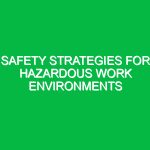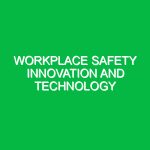In the realm of Health, Safety, and Environment (HSE), safety audits serve as a critical tool for ensuring that large facilities operate within the parameters of safety regulations and best practices. These audits are systematic examinations of a facility’s safety management system, policies, and practices, aimed at identifying hazards and assessing risks. With the increasing complexity of large-scale operations, the significance of safety audits cannot be overstated. They not only protect employees but also safeguard assets and ensure compliance with regulations. This article delves into the intricacies of safety audits for large facilities, exploring their importance, potential hazards, best practices, and relevant regulations.
Understanding Safety Audits for Large Facilities
Safety audits for large facilities encompass a structured process designed to evaluate safety performance and compliance with established standards. They facilitate a comprehensive review of the workplace environment, operational procedures, and safety policies. The audits typically involve a combination of interviews, document reviews, and physical inspections to gather pertinent information. Notably, these audits are not merely a compliance exercise; they are a proactive approach to identifying and mitigating risks before they lead to incidents.
The relevance of safety audits in the HSE domain is underscored by the significant consequences that can arise from neglecting safety. For example, a major manufacturing facility may experience a chemical spill that not only harms employees but also leads to costly downtime and legal repercussions. Safety audits help prevent such scenarios by fostering a culture of safety awareness and continuous improvement.
Identifying Potential Hazards and Risks
Large facilities face myriad hazards depending on their specific operations. Understanding these potential risks is the first step in conducting an effective safety audit. Common hazards include:
1. Chemical Hazards
Facilities that handle chemicals, whether in manufacturing or warehousing, are at risk of spills, leaks, and exposure. For instance, a plant that uses volatile solvents must ensure that all employees are trained in handling these substances and that proper containment measures are in place.
2. Physical Hazards
These include machinery, equipment, and work processes that can cause injuries. A classic example is construction sites, where falls, equipment malfunctions, and collisions are common hazards. Regular inspections can identify areas for improvement, such as the need for guardrails or personal protective equipment (PPE).
3. Ergonomic Hazards
In large facilities, repetitive motions and poor workstation design can lead to musculoskeletal disorders. A safety audit should assess workstation ergonomics and recommend adjustments to reduce strain on employees.
4. Fire and Electrical Hazards
Facilities must maintain stringent fire safety measures. Regular audits can identify potential fire hazards, such as blocked fire exits or inadequate fire suppression systems. Additionally, electrical systems should be inspected for potential overloads or outdated wiring that could pose a risk.
5. Biological Hazards
In industries like healthcare, there is a risk of exposure to infectious agents. Safety audits should include protocols for handling biological materials and ensuring proper sanitation practices.
Safety Precautions and Best Practices
Once potential hazards have been identified, the next step is implementing safety precautions and best practices to mitigate risks. Here are some actionable strategies:
1. Training and Awareness
Regular training programs are essential for ensuring that employees understand the hazards associated with their work and how to mitigate them. For instance, a large warehouse may conduct quarterly safety training sessions to refresh employees on safe lifting techniques and emergency procedures.
2. Regular Inspections and Maintenance
Establishing a routine for inspections and maintenance of equipment can prevent incidents. For example, a manufacturing facility should have a checklist for monthly equipment inspections, ensuring that all machinery is functioning properly and safely.
3. Emergency Preparedness
Large facilities must have comprehensive emergency response plans in place. Conducting regular drills for scenarios such as chemical spills or fires can prepare employees for real emergencies. A notable example is a chemical plant that regularly conducts fire drills, resulting in a swift and effective response during an actual emergency.
4. Incident Reporting and Analysis
Encouraging a culture of reporting near misses and incidents fosters an environment of continuous improvement. Analyzing these reports can help identify patterns and prevent future occurrences. For instance, a construction company that tracks near misses might discover that certain tasks consistently lead to unsafe conditions, allowing them to implement targeted interventions.
5. Personal Protective Equipment (PPE)
Ensuring that employees have access to appropriate PPE is vital. This includes hard hats, gloves, safety goggles, and respiratory protection, depending on the nature of the work. A facility should regularly assess the adequacy of its PPE provisions based on the risks identified during audits.
Regulations and Standards Governing Safety Audits
Safety audits for large facilities are governed by a variety of regulations and standards that vary by industry and location. Some key regulations include:
1. Occupational Safety and Health Administration (OSHA)
In the United States, OSHA sets forth regulations that outline the responsibilities of employers to maintain a safe work environment. Compliance with OSHA standards is critical for safety audits, as they provide guidelines for identifying and mitigating workplace hazards.
2. National Fire Protection Association (NFPA)
The NFPA develops codes and standards related to fire safety. Facilities must adhere to these standards when designing fire safety protocols and conducting audits.
3. International Organization for Standardization (ISO)
ISO 45001 is an international standard for occupational health and safety management systems. Implementing this standard can significantly enhance a facility’s safety practices, and regular audits are essential for compliance.
4. Industry-Specific Regulations
Many industries have specific regulations that govern safety audits. For example, the chemical industry must comply with regulations established by the Environmental Protection Agency (EPA) regarding hazardous waste management and chemical safety. Facilities must stay informed about the regulations relevant to their operations.
Conclusion
Safety audits for large facilities play a pivotal role in promoting a culture of safety and compliance within the HSE domain. By systematically identifying hazards, implementing best practices, and adhering to relevant regulations, organizations can significantly reduce risks and protect their most valuable assets: their employees. The process may seem daunting, but the benefits—ranging from improved employee morale to reduced liability—are well worth the effort. As the landscape of workplace safety continues to evolve, ongoing commitment to safety audits will be essential in navigating the challenges of large facilities.


